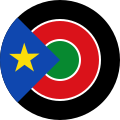This article has multiple issues. Please help improve it or discuss these issues on the talk page . (Learn how and when to remove these messages)
|
 | |
| Use | National flag |
|---|---|
| Proportion | 1:2 |
| Adopted | 9 July 2005 9 July 2011 (as national flag) 25 August 2023 (standardized) |
| Design | A horizontal tricolour of black, red, and green, fimbriated with white stripes; with a sky-blue equilateral triangle based on the hoist side bearing a yellow star |
The flag of South Sudan was adopted following the signing of the Comprehensive Peace Agreement that ended the Second Sudanese Civil War. [1] A different version of the flag was previously used as the flag of the Sudan People's Liberation Movement. The flag of South Sudan predates the country, as the flag was adopted in 2005, while the country became independent in 2011. [2] [3]
Contents
- History
- Description
- Colours
- Symbolism and representation
- Historical flags
- South Sudan as part of Anglo-Egyptian Sudan
- South Sudan as part of the Republic of Sudan
- South Sudan as the independent Republic of South Sudan
- Other flags
- Government flags
- Military flags
- Political party flags
- Miscellaneous flags
- Sub-national flags
- States
- Administrative areas
- See also
- Notes
- References
- External links






































